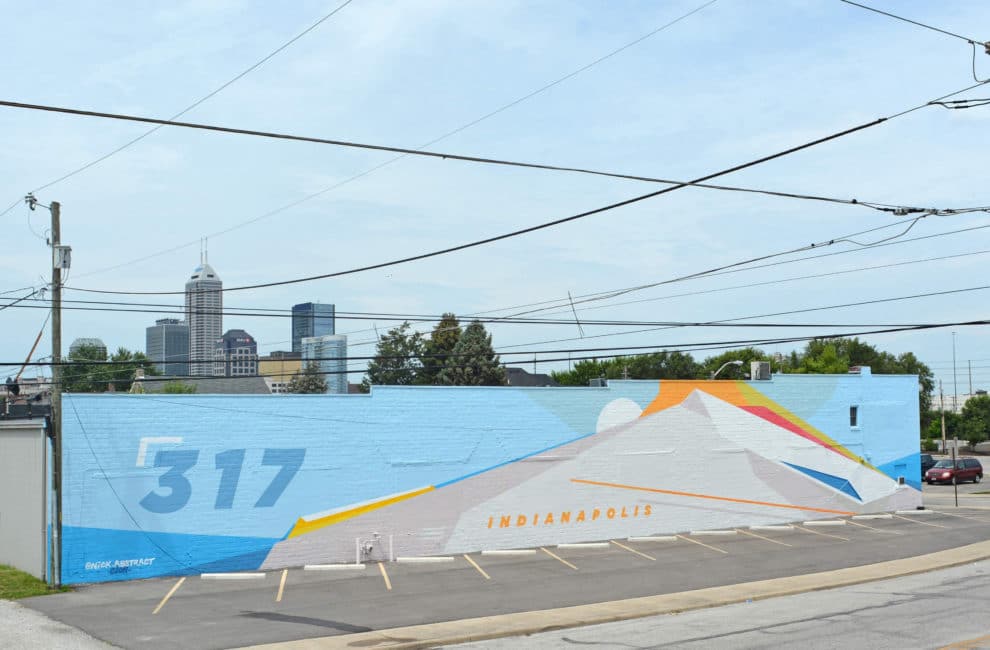Indy Mural Fest: Not Mucking Around

Midwest Suprematism by Nick Smith Courtesy Nick Smith
Indianapolis street artist Nick Smith, who came up with the idea for Indy Mural Fest, insists the upcoming event isn’t a response to graffiti writer Jules Muck’s wildly prolific stint in Indianapolis last August.
But he understands why you might think otherwise.
“I can see where it seems like the Muck thing was a catalyst for this,” Smith says. “But I’ve been planning this for a long time.”
Nevertheless, the Indy Mural Fest will occur in the still-turbulent wake of Muck’s summer tour of Indy, which garnered the California-based artist the kind of press and attention that most local artists only dream of. Jordan Lee Thomas, who co-founded the Indy Mural Fest with Smith, says that while Muck helped spark unprecedented interest in public art, her presence also sowed discord both within the artist community and between local artists and business owners. “It was hard to watch,” she says.
Muck is gone now, but more than 50 of her murals still dot the urban landscape. “The visual vibe of our city has been a little overwhelmed by one voice,” Shannon Linker, vice-president of the Arts Council of Indianapolis, says. “That’s probably not good, especially if it’s not a voice that authentically knows who we are.”
Indy Mural Fest organizers hope their event serves as a countervailing force to the city’s general tendency to be enamored of out-of-town talent. And while they welcome efforts by the Arts Council to support local artists, they say a grassroots effort is needed to bridge the gap between the art scene and local business owners.

Midwest Suprematism by Nick SmithCourtesy Nick Smith
“Mural artists here, and people who want to grow in that area, don’t have a lot of opportunity to grow,” Thomas says. “But if we can connect business owners to artists directly, that would probably help them get more opportunities.”
That, essentially, is what Indy Mural Fest is designed to do: bridge the gap between muralists and not only business owners, but the entire city of Indianapolis.

Map of Indy Mural Festival
While the free festival runs from Oct. 25-27, most of the live painting will take place from 2 to 6 p.m. on Saturday, October 26. Most of the festival’s 51 muralists will work on 20-foot stretches of Koch’s Electric and American Tent and Awning Co.—two businesses with large “legal” graffiti walls. Smaller businesses in nearby neighborhoods like Fountain Square will also be lending wall space to the festival.
“All of the painting locations are pretty close together,” Smith says. “And each one will have multiple artists working there.” The parking lot of Madison Lofts at 1400 S. Madison Ave. will serve as home base for the festival, featuring food trucks, music, art activities, and more.
Determining the subject matter of each mural has been “something of a delicate dance,” Smith concedes. “We’ve been very careful in communicating to business owners that we are giving artists full creative freedom,” he says. Still, all participating artists must sign a “non-offense form” giving the festival the right to replace any mural that the community deems inappropriate.
Smith and Jordan hope to make Indy Mural Fest an annual event. As for the expected turnout at this one, Smith says, “It’s going to be a mystery.”
”Nothing like this has ever been done in Indianapolis before,” he says. “But I’ve seen it work in other cities, where the events are huge and well-received. So I hope it takes off here, and opens a conversation about public art in Indy.”





